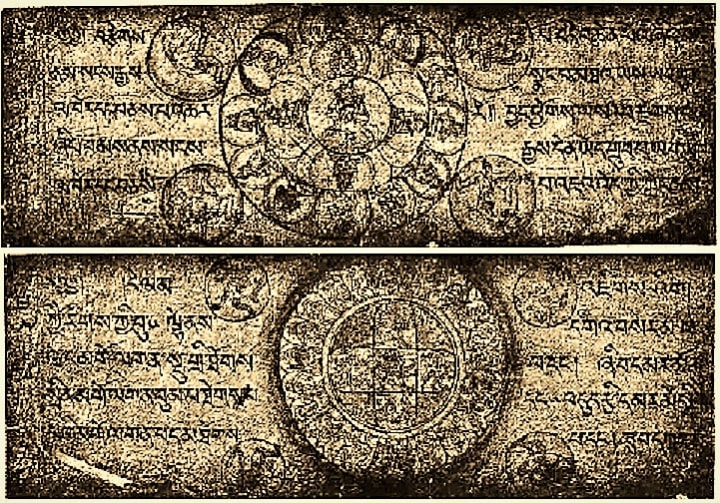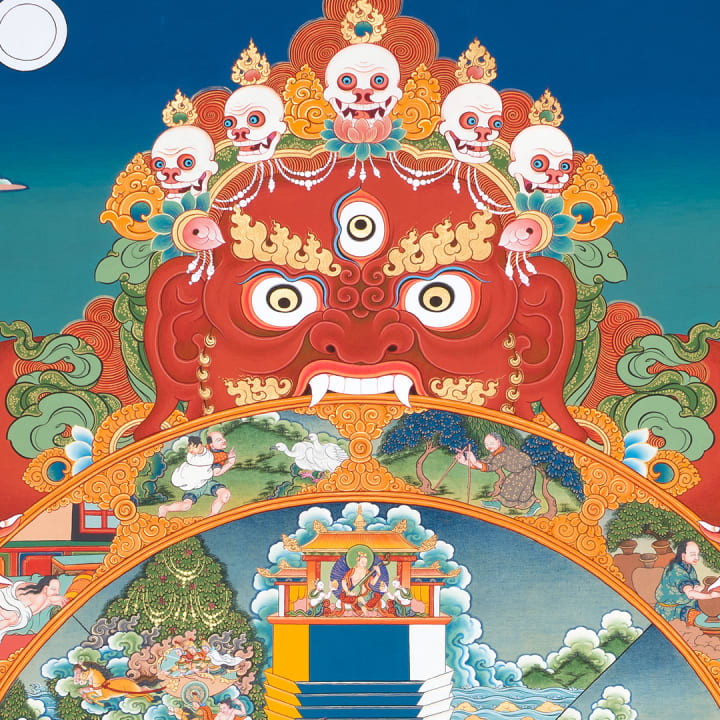The Tibetan Book of the Dead
"Liberation Through Hearing in the Bardo."

The Tibetan Book of the Dead, also known as the Bardo Thodol, is a text from the Tibetan Buddhist tradition that describes the process of dying and the afterlife. The book is traditionally read to a dying person to guide them through the various stages of the afterlife and help them achieve a good rebirth.
The text is divided into three sections or bardos, which are the stages of the afterlife. The first bardo begins at the moment of death and lasts for several days, during which time the deceased experiences a series of hallucinations and visions. The second bardo is the stage of the afterlife where the deceased encounters various deities and must choose a path to follow. The third and final bardo is the stage where the deceased either achieves enlightenment or is reborn into another form.
The Tibetan Book of the Dead is considered an important spiritual text in Tibetan Buddhism and has been translated into many languages. However, it is important to note that the text is not meant to be read as a literal guide to the afterlife, but rather as a metaphorical and symbolic text that can help people understand the impermanence of life and the nature of consciousness.

The Tibetan Book of the Dead, or Bardo Thodol, is divided into three main sections or bardos:
The Chikhai Bardo, which is the moment of death and the dissolution of the physical body. During this stage, the consciousness of the deceased person experiences various visions and hallucinations, which are the result of the dissolution of the five elements of the physical body.
The Chonyid Bardo, which is the intermediate stage between death and rebirth. During this stage, the consciousness of the deceased encounters various deities and experiences different states of mind. The deceased is urged to recognize the nature of reality and to let go of attachments and delusions.
The Sidpa Bardo, which is the stage of rebirth, where the consciousness of the deceased is reborn into a new form. The text offers guidance on how to achieve a good rebirth and avoid falling into negative states of existence.
Each of these sections is further divided into subsections, which provide detailed instructions and guidance on how to navigate each stage of the afterlife. The text also contains various mantras, prayers, and rituals that can be used to support the deceased and facilitate their journey through the bardos.

1The Chikhai Bardo
The Chikhai Bardo is the first bardo described in the Tibetan Book of the Dead, which is the moment of death and the dissolution of the physical body. During this stage, the consciousness of the deceased person experiences various visions and hallucinations, which are the result of the dissolution of the five elements of the physical body.
The Chikhai Bardo is further divided into three stages:
The Stage of the Clear Light of Death: At the moment of death, the consciousness of the deceased experiences a state of clear light, which is the nature of the mind itself. This stage is very important, as it is believed that the deceased has a unique opportunity to achieve enlightenment during this stage.
The Stage of the White Light: If the deceased does not recognize the clear light of death, they may experience the white light, which is a vision that arises from the element of water. The text warns that if the deceased becomes attached to this light, they will be drawn towards rebirth.
The Stage of the Red Light: If the deceased does not recognize the clear light or the white light, they may experience the red light, which is a vision that arises from the element of fire. This stage is associated with the onset of a more intense experience, and the deceased may encounter various deities and beings.
The text offers guidance on how to navigate each stage of the Chikhai Bardo, including various mantras and instructions on how to recognize and achieve enlightenment in the stage of the clear light of death. The purpose of the Chikhai Bardo is to help the deceased let go of their attachment to the physical body and prepare for the next stage of the afterlife, the Chonyid Bardo.
2.The Chonyid Bardo
The Chonyid Bardo is the second bardo described in the Tibetan Book of the Dead, which is the intermediate stage between death and rebirth. During this stage, the consciousness of the deceased encounters various deities and experiences different states of mind. The purpose of the Chonyid Bardo is to help the deceased recognize the nature of reality and let go of attachments and delusions.
The Chonyid Bardo is further divided into three stages:
The Stage of the Peaceful Deities: During this stage, the consciousness of the deceased encounters various peaceful deities, who represent the enlightened aspects of the mind. The deceased is urged to recognize the true nature of these deities and to let go of any attachment to them.
The Stage of the Wrathful Deities: If the deceased does not recognize the peaceful deities, they may encounter wrathful deities, who represent the unenlightened aspects of the mind. The deceased is urged to recognize these deities as aspects of their own mind and to overcome any fear or aversion towards them.
The Stage of the Clear Light: If the deceased recognizes the true nature of the deities, they may experience the clear light again. This stage is similar to the first stage of the Chikhai Bardo, but it is considered more intense and difficult to recognize.
The text offers guidance on how to navigate each stage of the Chonyid Bardo, including various mantras and instructions on how to recognize the true nature of the deities and achieve enlightenment. The purpose of the Chonyid Bardo is to help the deceased let go of any attachment to the physical body and to recognize the true nature of reality, which is the key to achieving a good rebirth.
3.The Sidpa Bardo
The Sidpa Bardo is the third and final bardo described in the Tibetan Book of the Dead, which is the stage of rebirth. During this stage, the consciousness of the deceased is reborn into a new form. The purpose of the Sidpa Bardo is to help the deceased achieve a good rebirth and avoid falling into negative states of existence.
The Sidpa Bardo is further divided into three stages:
The Stage of Karmic Vision: During this stage, the consciousness of the deceased is drawn towards a new existence based on their past actions (karma). The deceased may experience various visions related to their past deeds and may be drawn towards a particular state of existence based on their karma.
The Stage of Consciousness Taking Birth: If the deceased is drawn towards a particular state of existence, their consciousness begins to take on the form of a new being. The text offers guidance on how to achieve a good rebirth and avoid negative states of existence, such as the realms of suffering.
The Stage of Rebirth: During this final stage, the consciousness of the deceased is reborn into a new form. The text emphasizes the importance of continuing spiritual practice even after death, as it can influence the nature of one's rebirth.
The text offers various mantras, prayers, and instructions on how to achieve a good rebirth and avoid negative states of existence. The purpose of the Sidpa Bardo is to help the deceased continue their spiritual journey and achieve enlightenment in future lifetimes.





Comments
There are no comments for this story
Be the first to respond and start the conversation.